Installing a non-return valve in the sewer: rules for installing a water seal and a vacuum cleaner
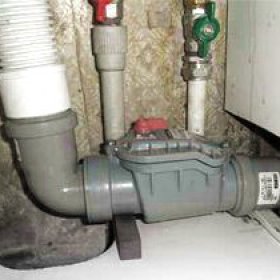
Residents of the first floors of high-rise buildings often face an extremely unpleasant situation when sewage drains flood their apartments. Fetid liquid can quickly spread through the room and cause serious material damage. To protect yourself from such troubles, it is enough to install a check valve for sewage, which will prevent the appearance of drains in the apartment. In this article, we describe the principle of operation and the installation procedure of check valves.
Content
Reasons for clogged sewage
It is naive to believe that clogging of sewer pipes occurs solely from the fact that large solid objects get into them. Rather, it is a trigger that drives a mechanism that has long been ready for operation. Often the problem lies elsewhere.
Incorrect outlet pipe slope
For normal operation of the system, it is necessary that the wastewater move through the pipeline at a certain speed. It provides a bias laid during the installation of the structure. If it was initially insufficient or decreased as a result of subsidence of the foundation during operation, the flow rate slows down.
In this case, larger solid inclusions will settle on the walls, since the current strength of the water will not be enough for their movement. Sooner or later, these deposits will completely block the pipe gap. Almost the same thing happens in the case of a too steep slope: the water simply does not have time to take the waste away.
Pipe Wear
Long-term operation of the system leads to a gradual uniform deposition of sediment on the pipe walls. The clearance inside the pipe is getting smaller and even with normal sink speeds, it is easier for large inclusions to gain a foothold on the walls. They accumulate, harden and form a blockage.
Installation of horizontal bends at right angles
Horizontal bends mounted at right angles dramatically change the configuration of the pipeline. This, in turn, changes the rate of runoff. They can both accelerate and slow down, which in any case will adversely affect the operation of the system, and will lead to the formation of blockage.
Do not forget about the improper operation of the structure, which also leads to problems.However, if in the latter case, cleaning the structure will be enough to get rid of the blockage, then troubles that occur for other reasons will appear with enviable regularity. That is why everyone whose apartments are on the first two floors, as well as owners of private houses, experts strongly recommend installing a shut-off valve for sewage.
Check valve: installation methods and types of devices
There are two ways to prevent a flood from sewage:
- by installing a separate locking device on each of the plumbing fixtures available in the apartment;
- installing one design with high throughput on a common pipe.
You need to know that the second option is suitable only for private houses, it is best for residents of high-rise buildings to use the first method.
There are two fundamentally different devices that are mounted in the sewer system:
- non-return valve to prevent reverse flow of wastewater;
- vacuum valve, equalizing the pressure in the system. It is recommended to install in buildings with a counter-slope, which is almost impossible to eliminate without a complete alteration of the pipeline.
Shut-off design: device and installation features
The assembly may be made of plastic or metal, the first option being more common.
Principle of operation
The part is equipped with two nozzles, exhaust and receiving. Between them is a chamber with an element filled with air, made in the form of a ball. How it works, you can see the illustration:

When fluid enters from the discharge valve, the shut-off element presses on the membrane, which closes the chamber. In addition, the design is equipped with a shut-off valve, which blocks the pipe if necessary
The unit needs regular cleaning, so it has a collapsible housing. Cleaning is easy enough. It must be carried out regularly, otherwise it will be impossible to block the pipe due to contamination on the inlet seal. The system can be mounted both vertically and horizontally.
Basic installation rules
Before you begin installation, you should determine the installation location, taking into account the need to ensure free access to the unit for cleaning and maintenance.
When choosing a device model, you need to be guided by common sense and not buy a part, just because you liked the price. The costs of a high-quality valve cannot be compared with the cost of repairing an apartment in the event of flooding by its drains. In addition, you need to pay attention to the installation method of the node. Most often they are universal, but there are separate models designed only for horizontal or vertical installation.
Another nuance: before installation, it is worth checking the valve for leaks. For installation, it is necessary to cut the desired size in the pipeline and insert it into the valve. If the sewage system is cast iron, then you will have to mount the adapters from metal to plastic. Installation of the part is carried out strictly in accordance with the direction of fluid flow. An arrow is shown on each valve to indicate this direction. It should be facing towards the sewer collector.
Check valve
According to SNiPs, in all buildings with more than two floors, a fan valve must be installed, in which case the sewage system will work more efficiently, without unpleasant odor and noise. The unit performs the functions of a distribution and control device that allows you to automatically remove the gases formed in the system and create an air flow.
How is the node arranged and functioning?
The principle of operation of the element is quite simple.Consider how a sewer system works without a valve. When draining water in the toilet or any other discharge of a large amount of liquid in the pipeline, a vacuum occurs. It forces the system to draw in air to equalize the pressure from the plumbing fixture, where the smallest water trap is the least. This moment will be accompanied by a loud squelching sound and the appearance of an unpleasant odor. The vacuum valve equalizes the pressure inside the sewer system, letting in air when a vacuum occurs, and releasing the gases generated inside the pipeline.
The standard part has a plastic housing with a side opening. The main structural element is a rod that raises the side opening through which the emission of gases from the sewer passes. When the pressure drops, the stem drops down and closes the hole. To prevent the element from rising higher than necessary, a rubber gasket is installed above it. There are units with a rubber membrane instead of a stem, but they require frequent replacement due to the rapid wear of the rubber.
Manufacturers offer two types of air valves:
- 50 mm for sinks;
- 110 mm for a common riser.
It should be borne in mind that the first node can be installed only for one or two devices, for example, for the toilet and sink.
Features of mounting the air valve
The part can only be installed in rooms with a constant positive temperature. With a negative node will not be able to function. The installation location is selected depending on the availability of a floor drain. If there is a ladder, then the valve is installed at a height of at least 35 cm from the floor.
The absence of a ladder involves the installation of the device on a pipeline section located above the highest input of the drainage coming from the plumbing equipment. Installation of the part is carried out by mounting on the free end of the pipe or in a special socket.

In the illustration - the principle of operation of the air valve. Note that it is installed by installing it on the free end of the pipe or in a special socket
It should be noted that installing a non-return valve on the sewer is a necessary measure. It will protect the apartment or private house from the penetration of sewage, unpleasant odors and noise. You can carry out the work yourself, having previously familiarized yourself with the installation instructions, or entrust the installation to specialists. In any case, the result will be trouble-free operation of the sewer system.
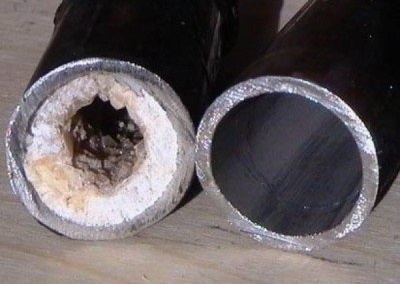
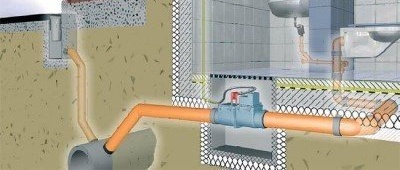
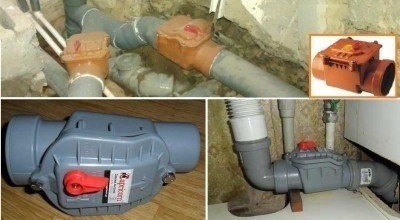
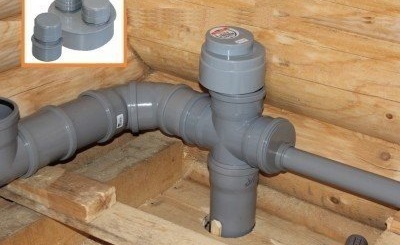
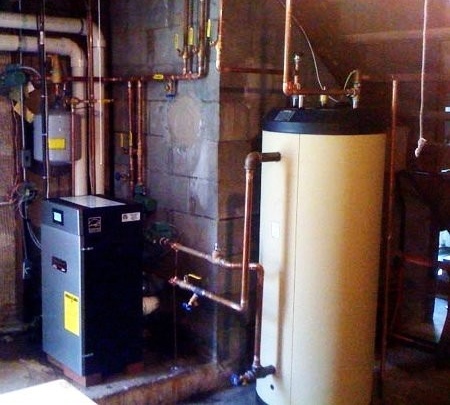
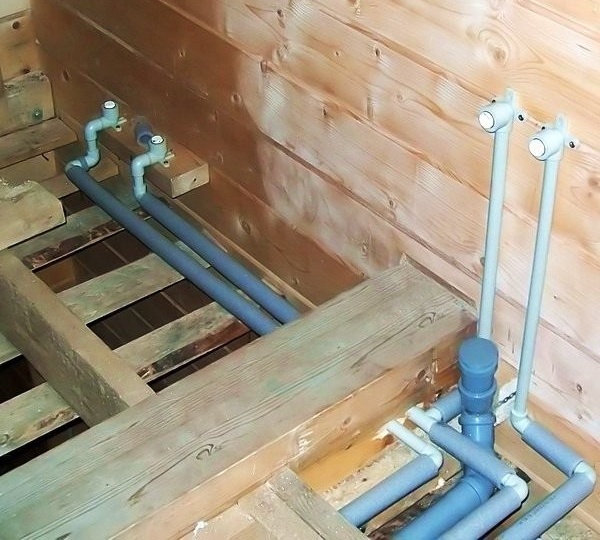

5 comments